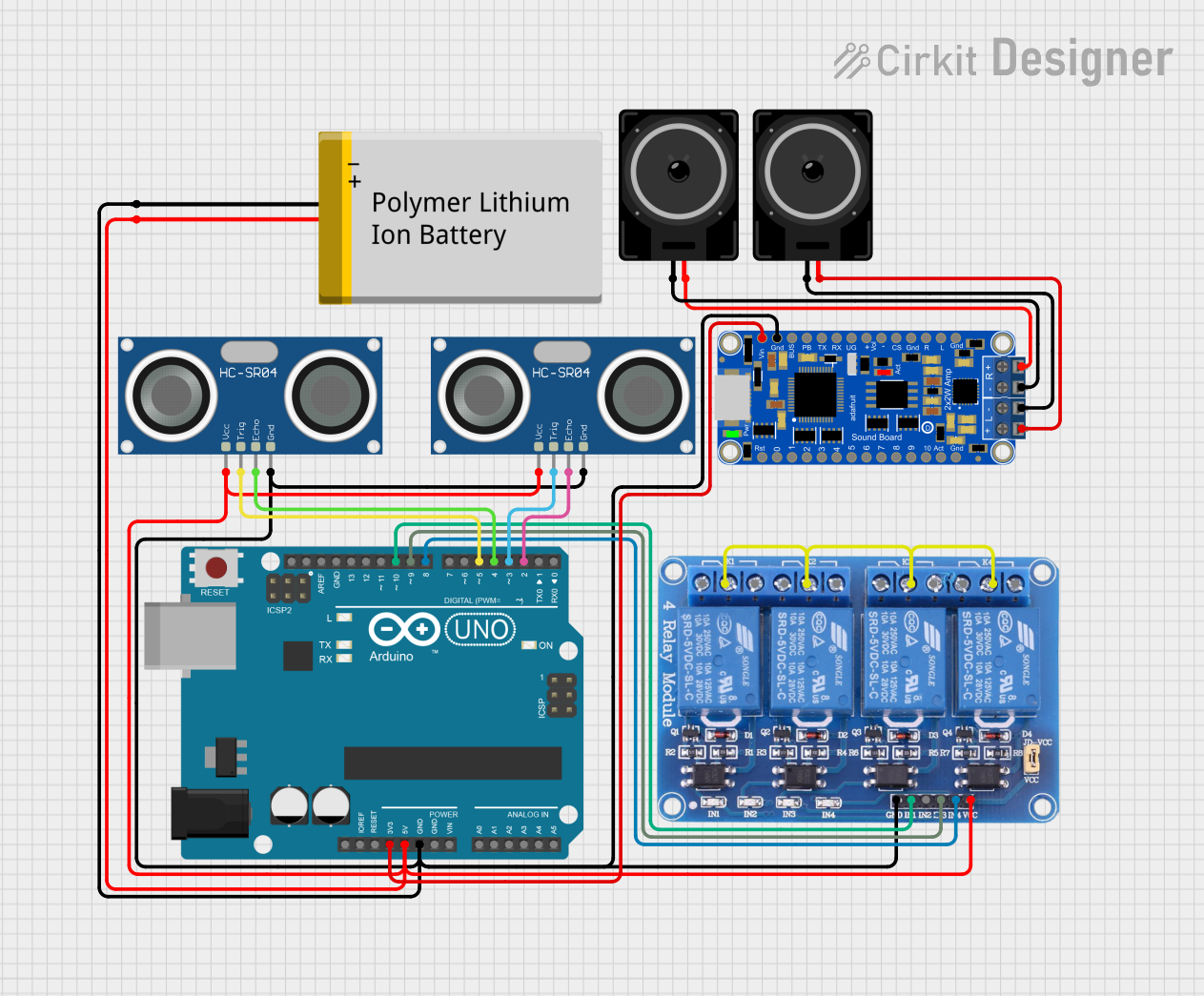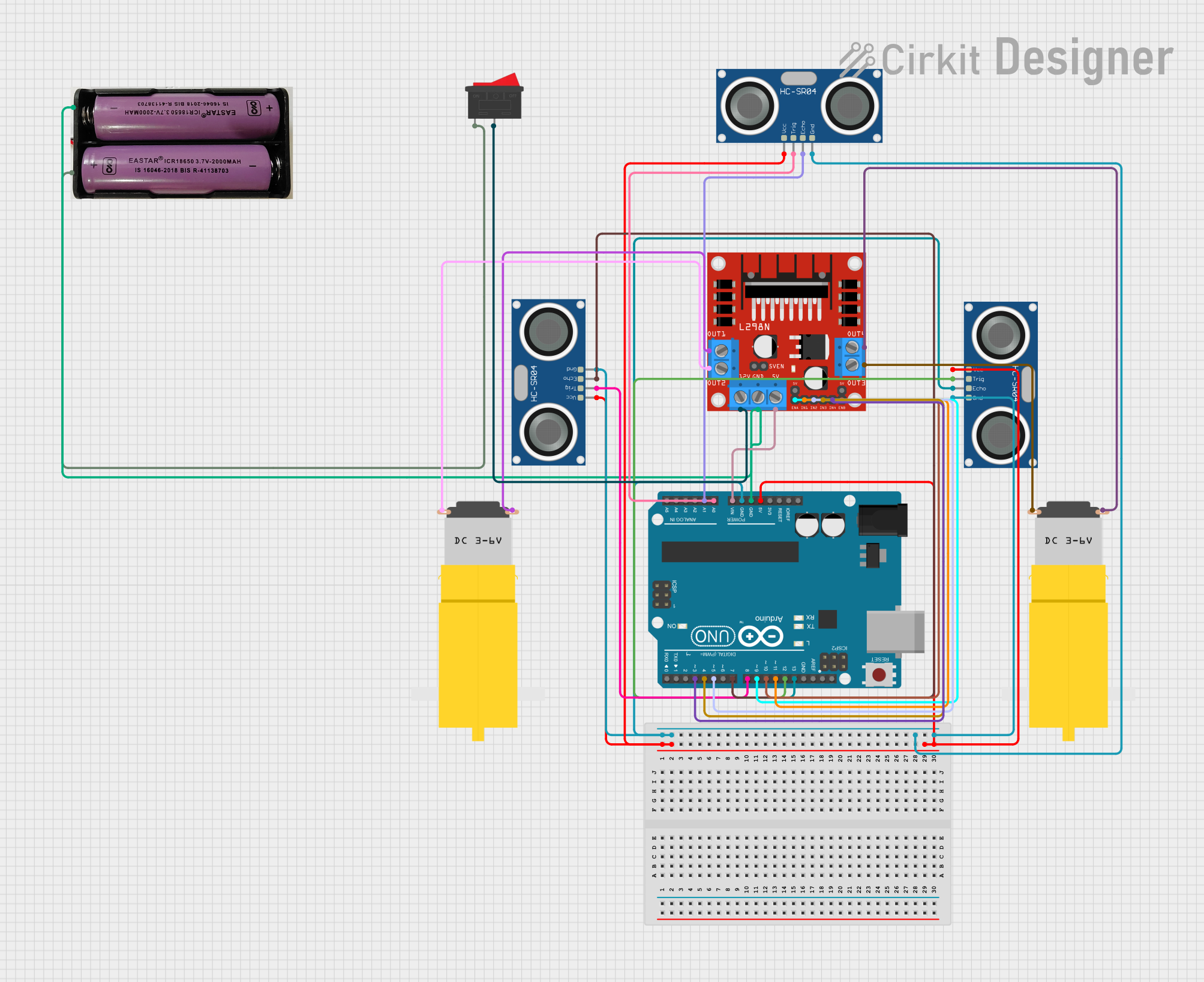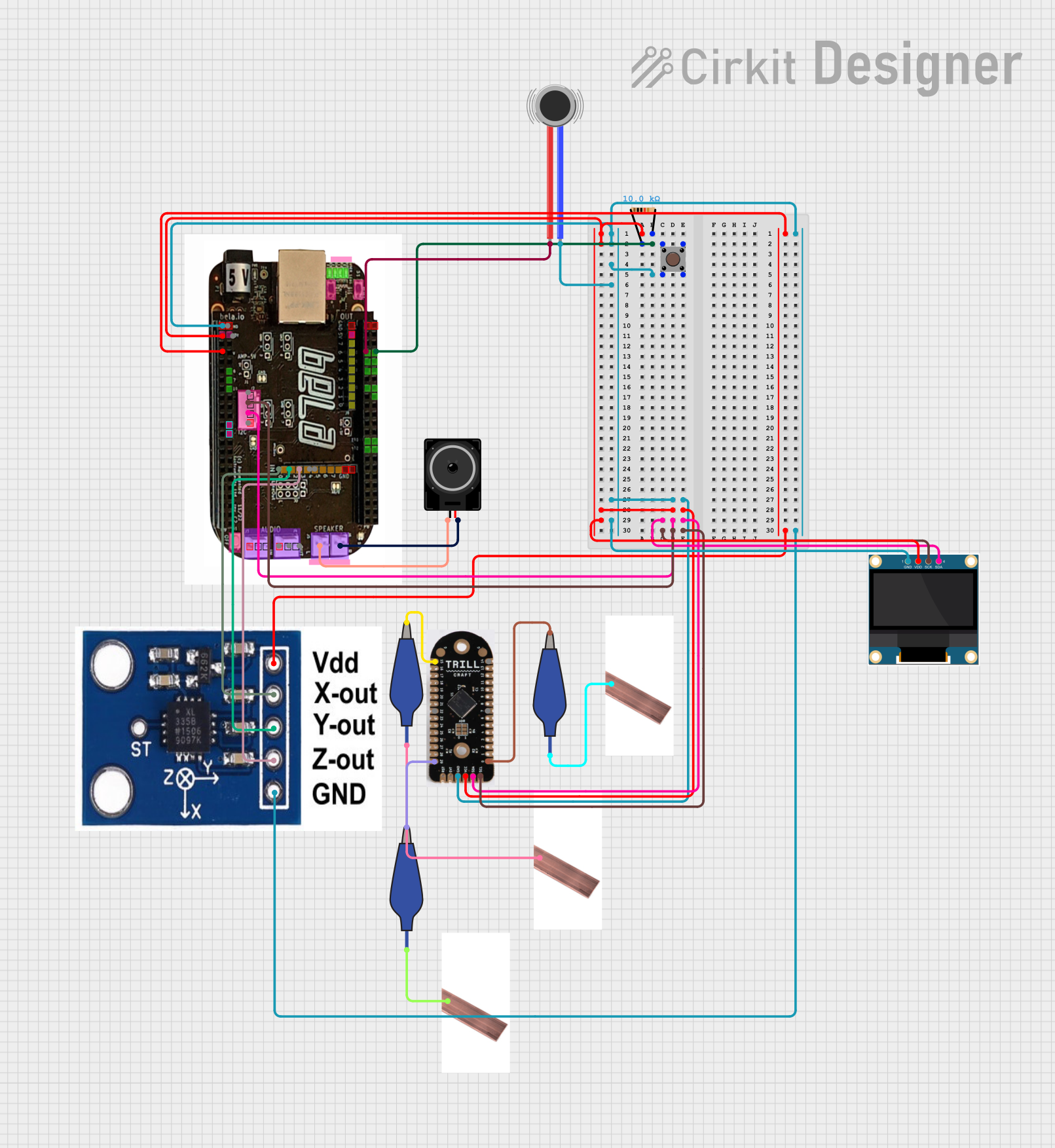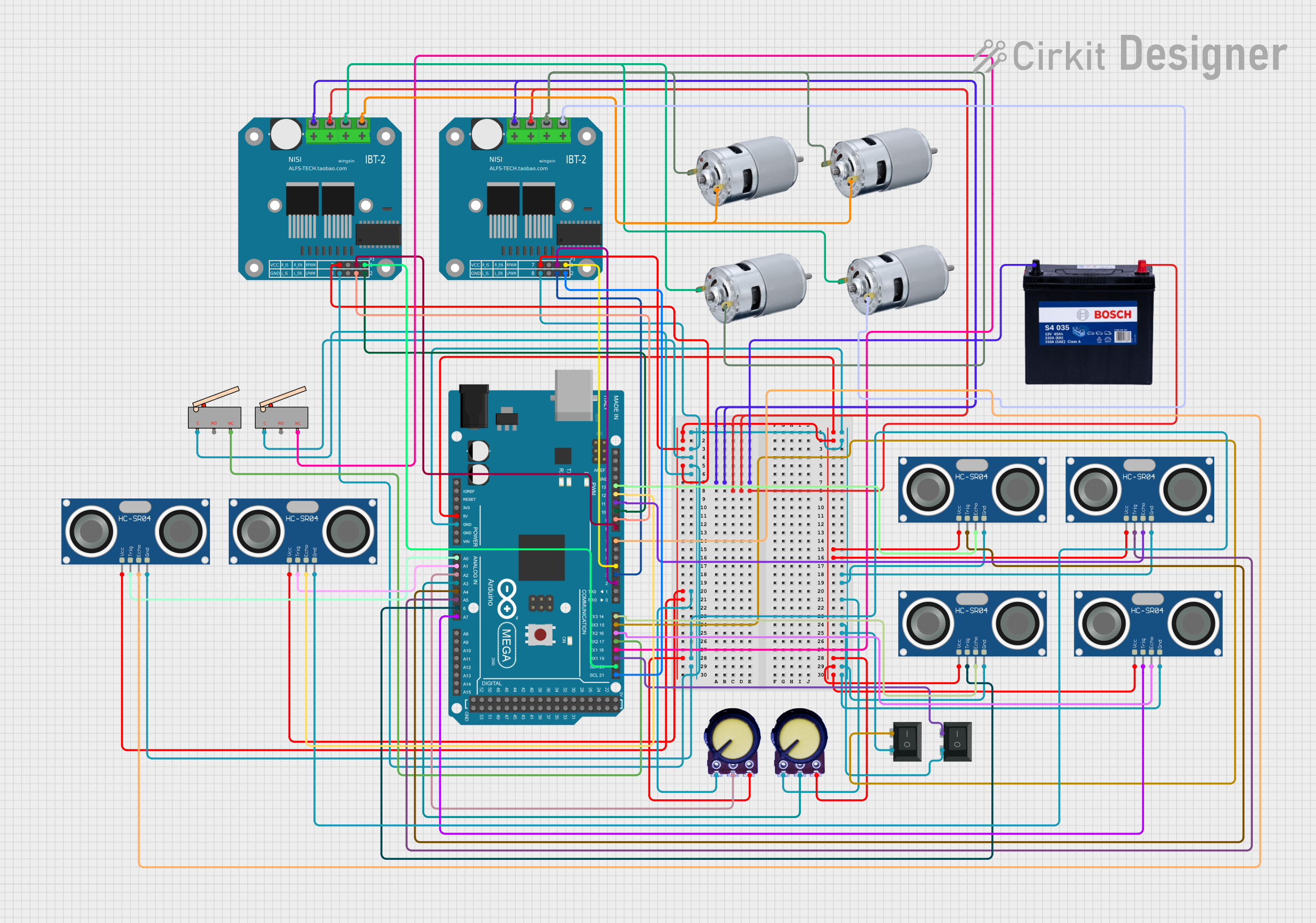
How to Use ULTASONIC: Examples, Pinouts, and Specs

 Design with ULTASONIC in Cirkit Designer
Design with ULTASONIC in Cirkit DesignerIntroduction
The ultrasonic sensor is an electronic component that uses high-frequency sound waves to measure distances or detect objects. It operates by emitting sound pulses and calculating the time it takes for the echo to return after bouncing off an object. This time is then converted into a distance measurement. Ultrasonic sensors are widely used in robotics, automation, automotive parking systems, and obstacle detection.
Explore Projects Built with ULTASONIC

 Open Project in Cirkit Designer
Open Project in Cirkit Designer
 Open Project in Cirkit Designer
Open Project in Cirkit Designer
 Open Project in Cirkit Designer
Open Project in Cirkit Designer
 Open Project in Cirkit Designer
Open Project in Cirkit DesignerExplore Projects Built with ULTASONIC

 Open Project in Cirkit Designer
Open Project in Cirkit Designer
 Open Project in Cirkit Designer
Open Project in Cirkit Designer
 Open Project in Cirkit Designer
Open Project in Cirkit Designer
 Open Project in Cirkit Designer
Open Project in Cirkit DesignerCommon Applications:
- Distance measurement in robotics
- Obstacle detection in autonomous vehicles
- Liquid level sensing in tanks
- Proximity detection in industrial automation
- Parking assistance systems in vehicles
Technical Specifications
Below are the key technical details of a typical ultrasonic sensor (e.g., HC-SR04):
| Parameter | Value |
|---|---|
| Operating Voltage | 5V DC |
| Operating Current | 15 mA |
| Operating Frequency | 40 kHz |
| Measuring Range | 2 cm to 400 cm |
| Accuracy | ±3 mm |
| Trigger Input Signal | 10 µs TTL pulse |
| Echo Output Signal | TTL pulse proportional to distance |
| Dimensions | 45 mm x 20 mm x 15 mm |
Pin Configuration and Descriptions
| Pin Name | Pin Number | Description |
|---|---|---|
| VCC | 1 | Power supply pin (5V DC) |
| Trig | 2 | Trigger pin: Sends the ultrasonic pulse |
| Echo | 3 | Echo pin: Receives the reflected pulse |
| GND | 4 | Ground pin |
Usage Instructions
How to Use the Ultrasonic Sensor in a Circuit
- Power the Sensor: Connect the VCC pin to a 5V power source and the GND pin to ground.
- Trigger the Sensor: Send a 10 µs HIGH pulse to the Trig pin to initiate a measurement.
- Receive the Echo: Measure the duration of the HIGH signal on the Echo pin. This duration corresponds to the time taken for the sound wave to travel to the object and back.
- Calculate Distance: Use the formula below to calculate the distance: [ \text{Distance (cm)} = \frac{\text{Time (µs)} \times 0.034}{2} ] The factor 0.034 represents the speed of sound in cm/µs, and the division by 2 accounts for the round trip of the sound wave.
Important Considerations and Best Practices
- Ensure the sensor is mounted securely and aligned properly for accurate measurements.
- Avoid placing the sensor near sources of ultrasonic noise, such as motors or other ultrasonic sensors.
- Use a capacitor (e.g., 10 µF) across the VCC and GND pins to stabilize the power supply.
- For best results, ensure the target object has a flat surface perpendicular to the sensor.
Example Code for Arduino UNO
Below is an example of how to use the ultrasonic sensor with an Arduino UNO:
// Define pins for the ultrasonic sensor
const int trigPin = 9; // Trigger pin connected to digital pin 9
const int echoPin = 10; // Echo pin connected to digital pin 10
void setup() {
// Initialize serial communication for debugging
Serial.begin(9600);
// Set pin modes
pinMode(trigPin, OUTPUT); // Trig pin as output
pinMode(echoPin, INPUT); // Echo pin as input
}
void loop() {
// Send a 10 µs HIGH pulse to the Trig pin
digitalWrite(trigPin, LOW);
delayMicroseconds(2);
digitalWrite(trigPin, HIGH);
delayMicroseconds(10);
digitalWrite(trigPin, LOW);
// Measure the duration of the HIGH signal on the Echo pin
long duration = pulseIn(echoPin, HIGH);
// Calculate the distance in cm
float distance = (duration * 0.034) / 2;
// Print the distance to the Serial Monitor
Serial.print("Distance: ");
Serial.print(distance);
Serial.println(" cm");
// Wait before the next measurement
delay(500);
}
Troubleshooting and FAQs
Common Issues and Solutions
No Output or Incorrect Distance Readings:
- Ensure the sensor is powered with 5V and properly connected.
- Verify that the Trig and Echo pins are connected to the correct Arduino pins.
- Check for loose or damaged wires.
Unstable or Fluctuating Readings:
- Add a capacitor (e.g., 10 µF) across the VCC and GND pins to filter noise.
- Ensure there are no obstructions or reflective surfaces near the sensor.
Sensor Not Detecting Objects:
- Ensure the object is within the sensor's range (2 cm to 400 cm).
- Verify that the object has a surface capable of reflecting sound waves.
FAQs
Q: Can the ultrasonic sensor detect transparent objects?
A: Ultrasonic sensors can detect transparent objects, as they rely on sound waves rather than light. However, the object's surface must be capable of reflecting sound waves effectively.
Q: What is the maximum distance the sensor can measure?
A: The maximum range of the sensor is 400 cm (4 meters), but accuracy may decrease at longer distances.
Q: Can I use the sensor with a 3.3V microcontroller?
A: While the sensor operates at 5V, you can use a level shifter to interface it with a 3.3V microcontroller. Alternatively, some ultrasonic sensors are designed to work with 3.3V systems.
Q: How do I avoid interference when using multiple ultrasonic sensors?
A: Trigger the sensors sequentially rather than simultaneously to prevent cross-interference between their sound waves.